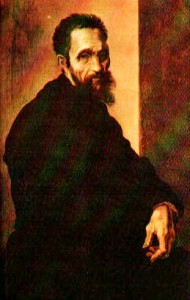Michaelangelo had assistants who moistened the plaster first, carried his equipment up the ladders, and who helped prepare the paints. Michaelangelo himself made full-size pencil sketches, distorted so they would view correctly on a curved surface from below, of every panel first. These were attached to the ceiling and small perforations were made through the sketch onto the plaster. He used these perforations to complete the sketches on the plaster before painting. Altogether the ceiling contains over 460 square metres of surface, which Michaelangelo covered with his paintings. The inspiration which guided Michaelangelo to create some of the world's most beautiful images was his religion. The Sistine Chapel ceiling and walls contain Michaelangelo's story of the Christian history of mankind. The Pope wanted Michaelangelo to paint Jesus' 12 disciples, but instead he painted scenes from the book of Genesis, such as 'God Separating Light From Darkness', 'The Creation of Adam', 'The Creation of Eve', 'The Temptation and fall of Adam and Eve', and 'The Flood'. In all he painted more than 3000 figures. |
